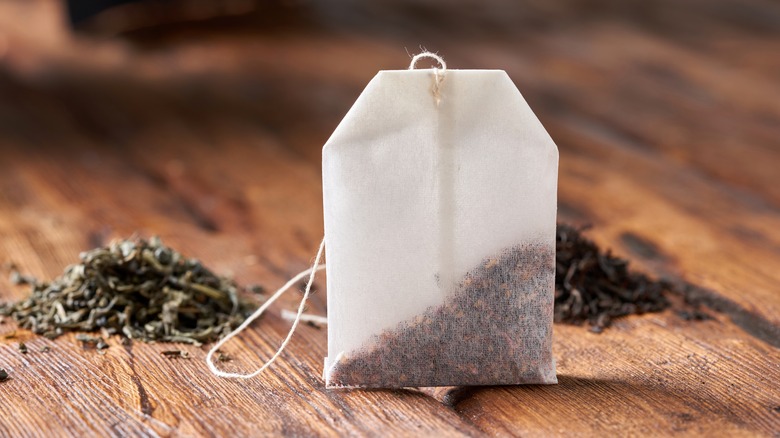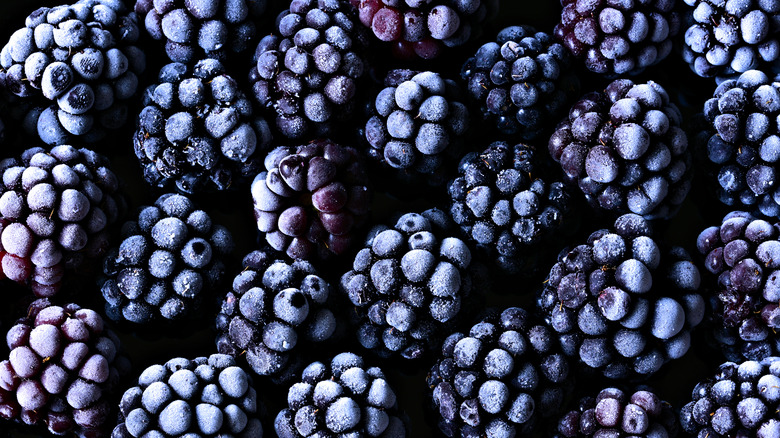14 Unexpected Ingredients To Add To Mulled Wine
When the temperature drops, and you're in the mood for a beverage, there's nothing more warming and comforting than mulled wine. When wine, spices, and citrusy aromatics come together in a pot and get cooked to warm perfection, the result is the ideal winter drink. Mulled wine works whether you're sitting by the fire with your family or hosting a festive get-together. But why settle for an average pot when you can make one that feels a little more special and out of the ordinary?
That's why I've collected this list of unconventional ingredients to add to your mulled wine. As a wine writer who is WSET Level-3 certified, I've created a guide to some nontraditional additions you may want to include in your next batch. Cinnamon, cloves, and oranges may be your go-to additions, but some less common spices, fruits, and even types of wine can make an unforgettable mulled wine this winter. So, turn on the stove, grab a cutting board, and get ready to get as cozy as possible. One nontraditional cup of mulled wine coming up!
Bourbon
Want to make your mulled wine a bit boozier than normal? If so, you may want to consider adding some bourbon to your mulled wine. Most mulled wine recipes call for brandy, but if you don't have any on hand — or just don't happen to like it very much — you can add bourbon instead. Bourbon will add depth and complexity without much effort on your part. Just make sure you don't add too much, as it can overwhelm the flavor of the finished product (and make you feel more tipsy than you intended).
If you really want to up the booze factor or just add an extra layer of flavor, you can add bourbon in addition to the traditional brandy. This makes for a rather intense version of the drink, though, so it may not be right for you if you're looking for the most drinkable mulled wine. But hey, on particularly cold nights, that extra bit of warmth may be exactly what you need.
Pomegranate juice
The flavor of mulled wine can be quite rich, which is deeply appealing to some drinkers and a turnoff to others. If you fall into the latter camp, there are ways you can make your mulled wine taste a bit lighter. Pomegranate juice is one of our favorite ways to do that. This is an ingredient that has plenty of body — it's going to work well with the rest of the ingredients you choose to add — but it also has a refreshing acidity that you won't find in most mulled wines. That way, you get some much-needed lightness without endangering the essence of the drink.
For the easiest and fastest results, you can just add some store-bought pomegranate juice. However, if you want to add some texture to the beverage, you can also sprinkle some pomegranate seeds right before you serve it. Cleaning fresh pomegranates takes some extra time and effort, but it makes for an especially festive-looking beverage.
Chai tea bags
Many — if not most — mulled wine recipes call for star anise and cloves. If you happen to keep these ingredients on hand for other recipes, you're in luck. You can simply add them to your mulled wine and get the same delicious results you always do. But if you look into your spice cabinet and realize that you actually don't have these ingredients, you may feel like mulled wine is out of reach. In reality, you may still have exactly what you need if you happen to have some chai tea bags hanging around.
Besides other spices, chai tea typically contains star anise and cloves, which means you can swap them with a tea bag if you don't have them stocked in your kitchen. Just add one or two tea bags to the wine, and you'll capture the same flavors you love in a traditional mulled wine recipe. Just make sure you take a close look at the caffeine content. You'll probably want to go for a caffeine-free version if you're enjoying your mulled wine at night.
Ruby port
Most traditional mulled wine recipes call for the addition of brandy. Not only does this make the beverage boozier than it would be with wine alone, but it also adds a smoothness and richness you wouldn't otherwise be able to achieve. But you don't always have to opt for brandy when you want to give your mulled wine a little extra oomph. If you're looking for something slightly less boozy — and something that can add a touch of sweetness to your beverage — consider adding some ruby port.
Ruby port is a Portuguese fortified wine (fortified just means the winemaker added a spirit to it, so the alcohol content cannot be attributed to the grapes alone). Unlike tawny ports, which can be more aged and complex, ruby ports are red, sweet wines that can add a lovely touch of flavor and a little extra alcohol to your mulled wine. Because they have a beautiful, cherry-like sweetness, they make a simple and delicious addition. Head to your local wine shop to pick up a nice ruby port, and get ready to experience what may be the best mulled wine you've ever tasted.
Fresh cranberries
During fall and winter, few fruits are celebrated more than the humble cranberry. It's tart with just a touch of sweetness and delivers a refreshing and bracing acidity to everything it touches. You may assume that cranberries should be reserved for sauces, but that's not all they're good for. In fact, they make an incredible addition to mulled wine. They deliver bright and zesty flavors that counteract with some of the heavier baking spices present in traditional recipes. The perfect balance of those contrasting elements creates a more harmonious sip.
If you want to keep things as easy as possible, you can simply pour some cranberry juice into your mulled wine — just keep in mind that most cranberry juices will impart a certain amount of sweetness to your final beverage. For those who really want to elevate their mulled wine, fresh cranberries are the way to go. They offer a perfect amount of flavor and make a beautiful garnish. Opt for frozen cranberries if you don't have fresh ones on hand.
Grapefruit
Citrus is a common ingredient in mulled wine recipes, mostly because the zesty citrus brightness can moderate some of the richer, more intense flavors in the drink. Most of the time, traditional recipes call for oranges, and sometimes, they'll require lemons. Unfortunately, other types of citrus seem to be relatively untapped. If you want to change things up in your favorite recipe, you may want to consider slicing up some grapefruit to add to the pot.
Grapefruit may not seem like an addition that makes a lot of sense, but hear us out. It has a lot of gripping acidity you get from other citrus fruits, but it lacks the sweetness you'd find in an orange. What you're left with is the same citrusy brightness with less sugar — perfect for those who prefer their mulled wine on the less sweet end of the spectrum. Plus, grapefruit slices look especially pretty in mulled wine. So, no need to make an extra run to the store just for a couple of oranges — just use the grapefruits you already have at home instead.
Candied ginger
When you think about it, mulled wine serves as a base for a wide variety of flavors to come together and blend harmoniously. This means you can easily play with different additions to make a version perfectly suited to your taste. Therefore, feel free to experiment with different ingredients you have on hand. One of our favorite unconventional add-ins just happens to be candied ginger. Sure, you may not see it listed in the ingredients section of most mulled wine recipes, but believe us, it can add a beautiful complexity to your beverage.
First and foremost, we love candied ginger because it offers a touch of subtle sweetness to the pot. This sweetness isn't overwhelming, as is the case with some other sugary ingredients, but it delivers just the right amount of lusciousness to the wine. But that's not all candied ginger offers. Under sugar, you'll find a sharp, almost spicy note that really makes for an interesting pot of mulled wine. You can either buy candied ginger, or make your own at home from scratch.
Compote
When you want extra sweetness, fruitiness, and maybe even a touch of chunky texture in your mulled wine, there are a few different ingredients you can add to the mix, but one of the best may be compote. What is compote, you ask? Well, it's basically fruit cooked in a sweet, sugary syrup, and it can make for an especially interesting addition to your mulled wine because it is such a multi-purpose ingredient. First and foremost, compote adds some extra sweetness to your mulled wine, which is ideal if you prefer a sweeter beverage. It also delivers on the fruit front, imparting extra fruity flavors to the drink. You can use different compote varieties — blueberry and peach work particularly well, but you can experiment with a wide variety of fruits.
Since compote tends to be relatively chunky compared to similar products such as jelly, it'll also deliver a bit of texture to your mulled wine. It's hard to find another ingredient that can add so much with so little effort.
Rosé wine
Most people think of mulled wine as a beverage made exclusively from red wine. Though it's true that the vast majority of recipes call for various types of red styles, you're not going to be disappointed if you go a different route. Red wine is classic, but that doesn't mean you always have to stick to it. In fact, you can make an incredible version using rosé wine.
Many of us tend to think of rosé as something to enjoy on a warm summer day, but if you prefer a slightly less intense version of mulled wine, then it can be amazing in a mulled form and perfect for enjoying during the coldest days of the year. Mulled wine made with rosé may not be quite as intense as its traditional cousin, but this might be what you're looking for. If you choose to use rosé instead of red wine, you may want to pull back a bit on the baking spices. Instead, utilize more fruity flavors in your recipe.
Almonds
Different cultures make different versions of mulled wine, and one of the more interesting varieties is the Swedish glögg. This version of the drink is quite potent, sometimes utilizing different spirits to create a stronger tipple than you may be accustomed to. But this Swedish variety is not different only because of the alcohol alternatives — it also contains almonds, giving an unexpected twist to anyone who isn't familiar with this tradition.
Almonds may not seem like the most flavorful ingredient to add to your mulled wine, but they add a lovely nutty quality that makes the drink feel seasonally appropriate. But don't worry — the nuttiness is quite subtle and definitely doesn't overpower other flavors. Whole almonds work well, of course, but you can also use slivered almonds for a more texturally interesting drinking experience. Once you try glögg, you may never go back to your old mulled wine recipe again.
Raisins
The Swedish version of mulled wine features raisins as another interesting addition you may want to consider adding to your own mulled wine. This is an extra ingredient that just makes sense. Mulled wine has a rich, intense flavor profile, usually built with red wine that has a touch of age and complexity. That's why raisins work so well here. They also capture that cooked fruit flavor profile we're going for in a pot of mulled wine, and they also add a touch of subtle sweetness. Plus, dried fruit generally makes more flavorful mulled wine.
But it's not all about the flavor when it comes to the raisins. They also add a textural component that gives you something to chew on while you sip. And who doesn't love a snack and a drink all in one package? Whether you make traditional glögg or you just decide to add raisins to your own favorite recipe, this is a treat you shouldn't miss out on.
Frozen blackberries
Fruit generally preforms well when added to mulled wine. However, some types of fruit work slightly better in this context, and blackberries just happen to be one of the best. First of all, they can be quite tart, which offers freshness and brightness you can't get from every fruit. Secondly, they have a deep and rich fruity flavor that works well with a wide variety of red wines you might use in your recipe. And if you want a sweeter flavor profile, you can specifically seek out riper blackberries.
Of course, you can always use fresh blackberries if you happen to have them on hand. However, fresh berries can be quite expensive — especially during the winter months — but luckily, the frozen variety works just as well. Besides being cheaper, you can add frozen blackberries just as your wine is finished cooking. As they will retain their shape, they can make an elegant fruity garnish.
Apple juice
Some people prefer a more bitter, dry profile when they drink mulled wine. However, there's a whole other camp of people who rather opt for a sweeter profile. If you fall in the second category, there are a few different ways you can sweeten the beverage. One of the easiest — and most delicious — ways to do it is to add some apple juice to the mix. Apple juice is easy to find and provides a subtle flavor without overpowering the wine.
There are a few different types of apple juice you can use. For the freshest results, you can juice your own apples with a blender at home. Sure, this is a time-intensive process, but it yields a truly standout mulled wine. If you choose to use a store-bought version, though, you may want to look for a cloudier apple juice. This variety tends to taste fresher than its clearer, more processed counterpart. Ultimately, though, any type of apple juice will do.
Vanilla
Best mulled wine recipes capture those warming, inviting flavors of the colder seasons. And what flavor is more warming and inviting than vanilla? That's why it makes such a lovely addition to mulled wine, especially if you've already included baking spices like cinnamon and cloves, as they often appear together in baked goods. In this case, it only makes sense to layer some vanilla on top to round out those hearty winter notes.
For the most cost-effective addition to your mulled wine, choose imitation vanilla. Sure, it's not the real thing, but it tastes very similar, and once you combine it with the other ingredients in your mulled wine recipe, you won't be able to taste a difference. Vanilla extract is a slightly pricier option that can offer a more complex flavor profile. Of course, vanilla beans can also work — just make sure you don't use too much, or it'll overpower other flavors you're working with.














